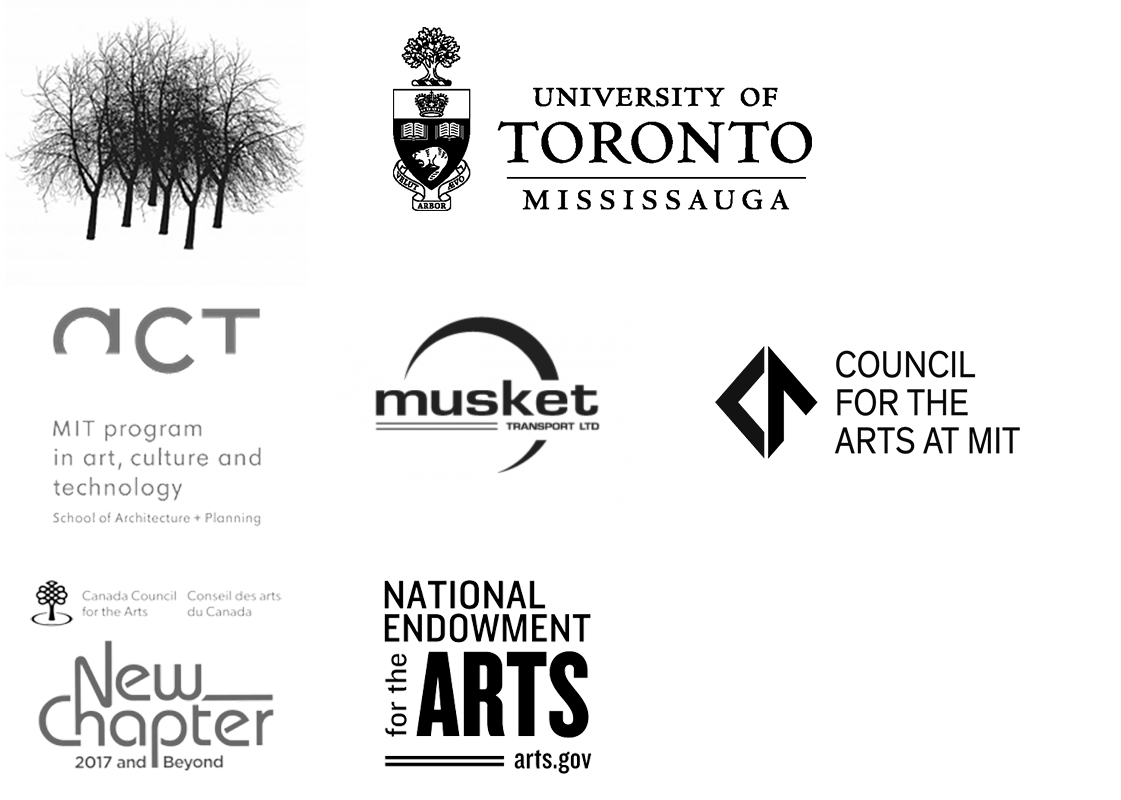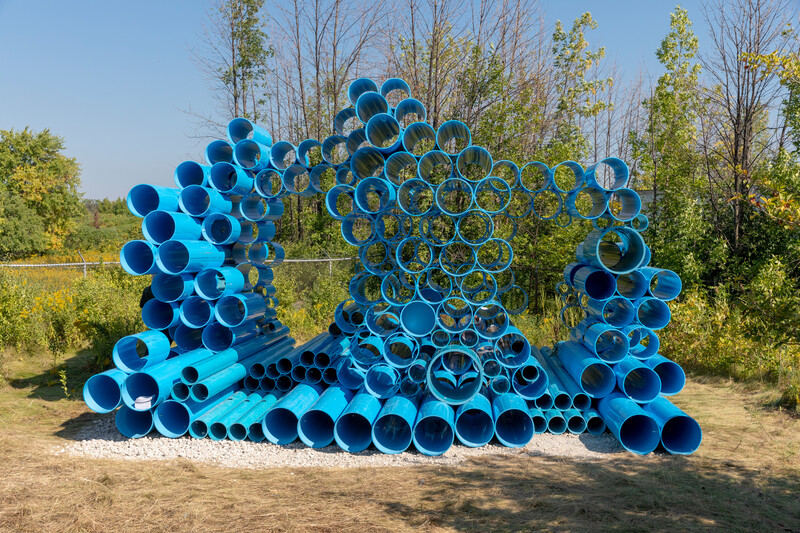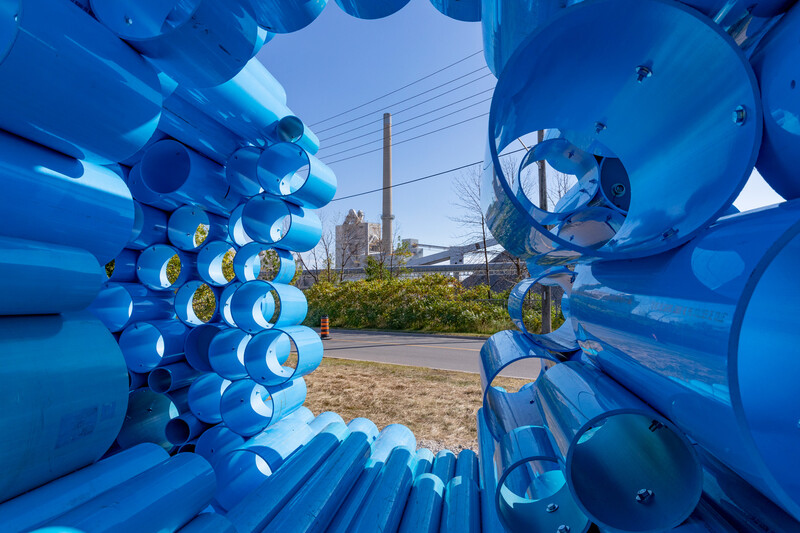
Futurity Island is an architectural structure conceptualized as a space for acoustic experimentation. It serves as an infrastructure that hosts sound compositions and performances that open space for learning.
Pipe is the primary structural and symbolic unit of the Island, referencing the material that has facilitated worldwide land reclamation throughout the modern era. Once used to drain swamps, pipe becomes a metaphor for a human-centered ecology, an infrastructure of environmental domination and one of the prime symbols of the Anthropocene. In Futurity Island, a network of pipes becomes an artificial skeleton that employs sound to channel what we used to call “nature.” Futurity Island builds a sound infrastructure that brings humans and non-humans into a more symmetrical, collaborative relationship, aiming to transmit and to hear the silenced voices of this planet.
By installing sonic transducers within the structure, Gediminas & Nomeda Urbonas create an organic, reverberating object that creates space for swampy mediations and acoustic experiments—using sound as a quaking force that destabilizes both architectural space and the human misconception that we are “builders of the environment.”
Futurity Island at Massachusetts Institute of Technology
First presented at The Work of Wind: Air, Land, Sea in September 2018, Futurity Island was disassembled into individual pipe sections, and repacked into a single 53’ Musket Transport Ltd. trailer to be trucked from Mississauga to Cambridge, MA. With Futurity Island’s “swamp” making a cross-border transit, the work moves through geographies and infrastructures shaped by human restructuring of natural space—at the Massachusetts Institute of Technology, Futurity Island will be reassembled to animate the local environment alongside the Charles River. At a new site following its first presentation near Lake Ontario, Futurity Island’s pipe serves as a conduit to amplify and reverberate the cultural and environmental histories of each location.
Futurity Island builds on the legacy of MIT’s Center for Advanced Visual Studies’ Charles River Project, a program held in the early 1970s aimed at connecting the campus to riparian environmental concerns. In engaging this history, Futurity Island calls for creative solutions for climate change adaptation, and highlights the challenges and opportunities for future life on and with the water.
Amphibian Songs
The exhibition of Futurity Island at MIT also marks the launch of Amphibian Songs, a 12” vinyl LP conceived by the artists with audio by Nicole L’Huillier. L’Huillier’s composition amplifies the story of the site where this work was first installed—Mississauga’s Southdown Industrial Area—and explores how nature and toxicity relate to each other. In the composition, the sonification of environmental data—the physics of the soil, the components affecting the land, and the winds—create an amphibian song of a distorted land.
Nicole L'Huillier, Amphibian Songs (excerpt)
Futurity Island at MIT
Curated by Christine Shaw
Walker Memorial – West Lawn
Massachusetts Institute of Technology
Cambridge, MA
Project
Installation Views




- Artists
- Gediminas & Nomeda Urbonas
- Collaborating Artist
- Tobias Putrih
- Collaborating Architect
- Indrė Umbrasaitė
- Collaborating Sound Artist
- Nicole L’Huillier
- Curator
- Christine Shaw
Shaw’s work convenes, enables, and amplifies the transdisciplinary thinking necessary for understanding our current multi-scalar historical moment and co-creating the literacies, skills, and sensibilities required to adapt to the various socio-technical transformations of our contemporary society. She has applied her commitment to compositional strategies, epistemic disobedience, and social ecologies to multi-year curatorial projects including Take Care (2016–2019), an exhibition-led inquiry into care, exploring its heterogeneous and contested meanings, practices, and sites, as well as the political, economic, and technological forces currently shaping care; The Work of Wind: Air, Land, Sea (2015–2023), a variegated series of curatorial and editorial instantiations of the Beaufort Scale of Wind Force exploring the relentless legacies of colonialism and capital excess that undergird contemporary politics of sustainability and climate justice; and OPERA-19: An Assembly Sustaining Dreams of the Otherwise (2021–2029), a decentralized polyvocal drama in four acts taking up asymmetrical planetary crisis, differential citizenship, affective planetary attention disorder, and a strategic composition of worlds. She is the founding editor of The Society for the Diffusion of Useful Knowledge (Blackwood, 2018–ongoing), and co-editor of The Work of Wind: Land (Berlin: K. Verlag, 2018) and The Work of Wind: Sea (Berlin: K. Verlag, 2023).
Annie Lundsten, MIT ACT
Project Coordinator
Fraser McCallum, Blackwood Gallery
Installation Technicians
Jasper Akitt, Layne Hinton, Gareth Lichty, BRM Production Management
Transportation
Ildar Samerkhanov, Musket Transport
This project is supported in part by an award from the National Endowment for the Arts, the Massachusetts Institute of Technology, the MIT Program in Art, Culture and Technology, the Center for Art, Science & Technology, the School of Architecture and Planning, Blackwood Gallery, University of Toronto Mississauga, Musket Transport, and IPEX.
Futurity Island, 2018 was commissioned by Blackwood Gallery for The Work of Wind: Air, Land, Sea, curated by Christine Shaw.


The Blackwood
University of Toronto Mississauga
3359 Mississauga Road
Mississauga, ON L5L 1C6
[email protected]
(905) 828-3789
The galleries are open. Hours of operation: Monday–Saturday, 12–5pm.
Facebook | Twitter | Instagram
Sign up to receive our newsletter.
The Blackwood is situated on the Territory of the Mississaugas of the Credit, Seneca, and Huron-Wendat.

